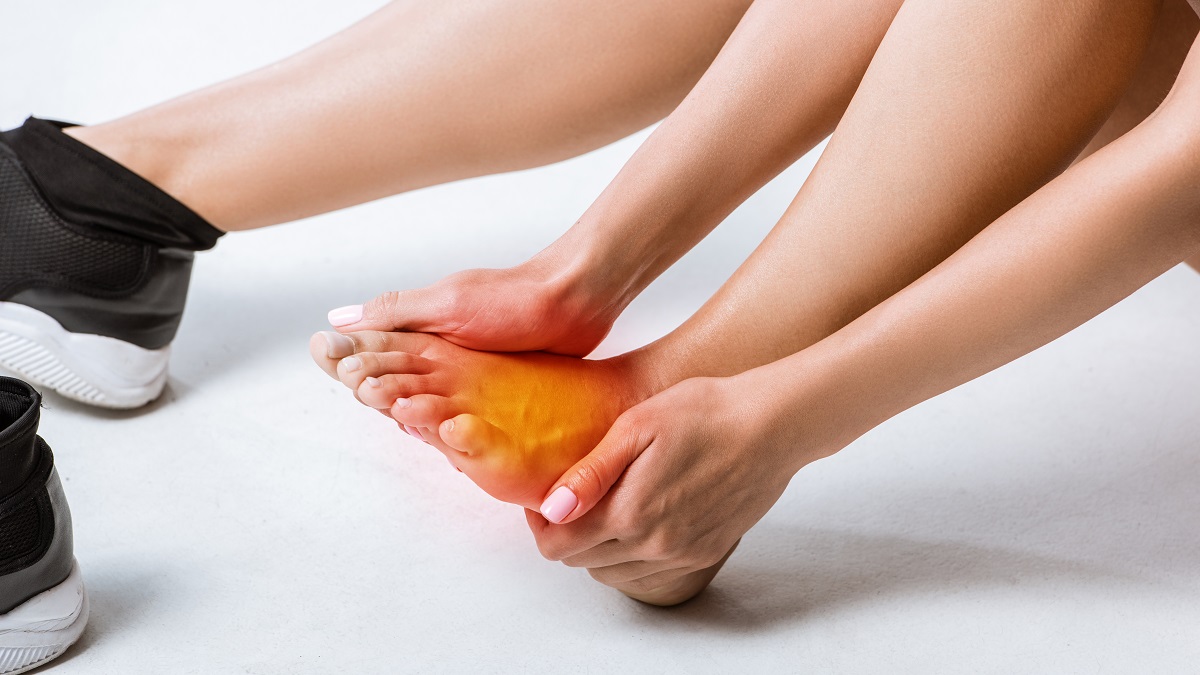Musculoskeletal leg pain involves pain that develops in any of the tendons, ligaments, and muscles in the lower extremities. Conditions ranging from tendinitis to arthritis may be the source of your discomfort. Although this type of pain most frequently develops in the lower back, pain in the leg, hip, knee, or ankle is also common. Musculoskeletal leg pain causes vary from patient to patient. They can range from serious physical disorders to more benign stresses from daily life. Here’s the most common causes, as well as ways to prevent musculoskeletal leg pain.
What do we mean by musculoskeletal leg pain?
Leg pain is a broad category of pain that can occur anywhere in the upper or lower leg. It can range in intensity from a dull ache to a sharp, stabbing pain. There are multiple causes of leg pain and some can be very serious. Others can be controlled or cured with rest and at-home care, especially proactive treatments that then help prevent leg pain in the future. Acute leg pain will go away after treatment but if pain does not stop after three months, it is considered chronic and may require different treatments to alleviate.
Click Here to Visit the Store and find Much More….
Leg pain usually originates in one of three systems in the human body: the musculoskeletal system, the nervous system, or the circulatory system.
Musculoskeletal leg pain occurs in the muscles, ligaments, tendons, and bones in the leg. Pain originating in the nervous system will usually cause sharp, radiating pain down the sciatic nerve resulting in a condition referred to as sciatica. Circulatory system pain in the leg can feel similar to a condition that affects the musculoskeletal system but is often more typically felt in only one side of the body.
Musculoskeletal leg pain typically doesn’t arise from a disorder or medical condition. About 33% of adults experience pain from overusing their muscles, according to the Cleveland Clinic.
In the case of overuse, acute musculoskeletal leg pain could develop from a particularly intense workout. Even carrying a golf bag has been shown to cause musculoskeletal distress in the ankle, according to a study published in the American Journal of Sports Medicine.
Frequently, musculoskeletal leg pain arises from muscle sprains or strains. A sprain occurs when a ligament stretches beyond its capacity or tears. Ligaments are the tissues that connect bones to one another. A strain, meanwhile, involves injury to the muscle or tendon. A tendon is tissue that connects muscle to bone.
While sprains more commonly occur during falls or sports injuries, strains are usually the result from overuse, according to the American Academy of Orthopaedic Surgeons (AAOS). However, strains can also result from overstretching. In the leg, the hamstring muscle is easily susceptible to strains, particularly for athletes. The hamstring is actually made up of three separate muscles that run from the bottom of the pelvis to below the knee. Hamstring tendons connect the muscle to the bone.
Potential hamstring injuries include strains in the muscle itself. Tendonitis—inflammation or irritation—can also develop in the connective tissues. Runners sometimes report high hamstring tendonitis in the portion closest to the pelvis.
Although leg musculoskeletal pain causes are often discussed in terms of overuse, some researchers advocate reframing the issue as underuse. In the British Journal of Sports Medicine, researchers argued that muscle use was not the problem. The problem was that the muscles had not been used prior to running, jumping, or participating in some other type of activity normally avoided in a person’s mostly sedentary lifestyle. They wrote:
“Articles are often written assessing “injuries” with the implication that they were the result of movement. This explanation, although sequentially accurate, neglects to focus on the fact that a lack of previous movement is more likely the true source.”
To drive the point home, researchers reviewed several studies and found adults who maintain robust exercises regimens typically experience less musculoskeletal pain—not more.
The researchers concluded that while pushing the body too hard may result in injury, not exercising at all increases the risk of injury when a person finally does exercise. Researchers wrote that:
“A review of the current science implicates that too little activity over time may in fact be the primary cause of a large percentage of musculoskeletal injuries… People are more likely to exercise too little than too much.”
Sedentary people who begin vigorously exercising likely put themselves at risk for musculoskeletal injuries. To avoid injury, consider easing into exercise gradually and stay mindful of the body’s physical limits.
Shin splints are characterized by pain on the shin—the bone in the front part of the lower leg. Common in athletes and dancers, shin splints often develop from overuse or changes in exercise routines. This is an acute condition that can be eased through rest and icing the affected area.
Shin splints can re-occur, but wearing supportive shoes and easing up on the exercise can help stave off this type of musculoskeletal leg pain.
Click Here to Visit the Store and find Much More….
Arthritis is one of the most common musculoskeletal disorders affecting nearly 70% of people over age 65 and thousands of younger people in the U.S., according to the Arthritis Foundation.
The most common form of arthritis is osteoarthritis, a degenerative joint disease in which the cartilage in joints breaks down, causing inflammation and pain. Rheumatoid arthritis is a systemic, autoimmune disease, which means the body’s immune system fights the body as if it were a foreign virus. Either type of arthritis may result in musculoskeletal leg pain. Common areas this discomfort affects are the hip, knee, ankle, and foot.
Arthritis in the hip can lead to trouble walking and pain in nearby areas, such as the thigh or knee. Pain in the foot or ankle is especially common in people with rheumatoid arthritis, with more than 90% of patients reporting musculoskeletal pain in those areas, according to the AAOS.
Widespread, musculoskeletal pain is fibromyalgia’s defining characteristic. Researchers aren’t sure how or why the condition develops, but it affects about 2% of the total population, according to the Centers for Disease Control and Prevention (CDC).
Women are at much higher risk of developing the disorder, with the CDC reporting a 7:1 ratio of women to men.
The disorder sometimes develops after a physical trauma, infection, surgery, or significant episode of stress. Other times, the onset seems random and cannot be attributed to any sort of physical or mental trigger. The condition is believed to run in families, and may have a genetic component.
Whatever the cause, fibromyalgia is believed to induce widespread musculoskeletal leg pain by interfering with the way the brain processes pain. Neurotransmitters that signal pain elevate to abnormally high levels. Meanwhile, receptors in the brain become more sensitive to pain signals, overreacting to the brain’s efforts to communicate distress.
Fibromyalgia’s musculoskeletal pain often manifests as a dull ache as opposed to a shooting or stabbing sensation. Fibromyalgia patients also experience pain above the waist. Other symptoms include:
- Fatigue
- Sleep apnea
- Cognitive difficulties such as trouble concentrating or focusing
- Depression
- Headaches
- Abdominal cramping
Preventing the most common musculoskeletal leg pain causes
There are several things you can do to prevent musculoskeletal leg pain in your life. They include the following.
Balanced nutrition is essential to maintain healthy body systems throughout our lives. Particularly, doctors recommend foods that maintain a good balance of potassium for healthy legs. Both high and low levels of potassium can be dangerous.
Also, the correct amount of calcium and magnesium can help prevent leg pain and degenerative conditions that affect the hips and knees, such as osteoarthritis or osteoporosis. However, always talk to your doctor or a nutritionist before changing your diet too drastically.
Many sports injuries such as strains and sprains can be prevented with the correct pre-game or workout stretching routine. Add some easy leg stretching routines before you exercise every day to prevent leg pain.
Stretching can not only help prevent injury but it can also help rehabilitate your legs after you’ve suffered from a sports injury. Standing quadriceps flexes, hips flexor stretches, and calf stretches can help before any exercise routine.
Another key to prevent leg pain is to keep your activity low impact. In fact, the aerobics craze of the 1980s actually led to permanent, lifelong injuries for some of the individuals who embraced the culture.
The good news is that low-impact exercise is easy to do and most of the time doesn’t require any additional accessories, except for the proper footwear. Walking is the easiest way to start a low-impact exercise routine. If you’ve not exercised much before, start slowly with an easy walk around your block and add time and distance as you begin to build more stamina and get more comfortable with the activity.
Click Here to Visit the Store and find Much More….
Most people don’t realize how dehydration can affect our systems. By the time you feel thirsty your body is already experiencing dehydration. Lack of hydration can lead to muscle cramps.
Individuals can forget to stay hydrated while engaging in physical activity. It may be easy to remember your water bottle when you’re hiking, but do you think about it when you’re working in your yard?
While frequent massages may seem self-indulgent they can really help keep your body balanced and restored. A massage greatly helps sore muscles, increases circulation, and makes you feel more relaxed.
A trained massage therapist can work with you to pay certain attention to parts of your legs where you may be experiencing minor discomfort. It can also be a great way to treat yourself once in a while.
This Eastern meditative practice has become very popular in the United States. Yoga can help you maintain mind and body balance. It’s also a great low-impact stretching workout for the muscles in your legs.
Poses such as chair, warrior pose, warrior II pose, and the standing forward bend are all great for leg strength. As a bonus, you can also use yoga poses for your pre-exercise stretching routine.
Does a daily walk around your neighborhood sound boring and repetitive to you? Hiking can be a great way to add more scenic walking to your routine.
Depending on where you live, you can hike in river valleys, mountains, or the woods. You could even join a hiking group to make it a more social activity. Always remember to stay safe on the trail, bring plenty of water, and wear appropriate hiking boots that fit well.
Another low-impact activity that can help prevent leg pain and provide a little more excitement than a regular walk is golf.
By skipping the motorized golf cart you get your walking exercise in as you go from hole to hole and the correct swing technique also stretches the muscles in your legs. Like hiking, golf is also a great group activity.
Your doctor can help you with any questions you have about your body. While we often turn to them only after there is a concern or a problem, doctors really do have a desire to proactively help prevent injuries and illnesses in their patients. If you want to know more about ways to prevent leg pain in your life, your doctor is a great resource.

Click Here to Visit the Store and find Much More….
For More Information Related to Fibromyalgia Visit below sites:
References:
Fibromyalgia Contact Us Directly
Click here to Contact us Directly on Inbox
Official Fibromyalgia Blogs
Click here to Get the latest Chronic illness Updates
Fibromyalgia Stores

